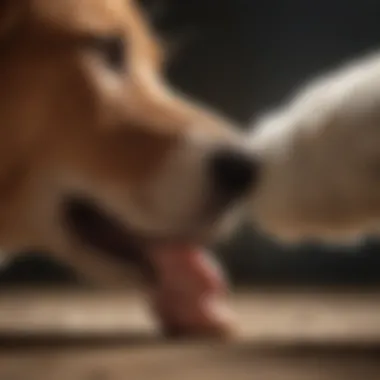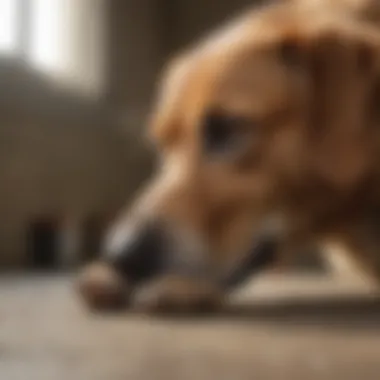Understanding Why Dogs Lick Their Paws: Insights Revealed


Intro
By investigating the underlying reasons behind paw licking, we can better care for these companions and enhance our understanding of their needs. Recognizing when licking becomes a problem is crucial for prevention and intervention. Let’s delve into the details.
Prolusion to Paw Licking
Defining Paw Licking Behavior
Paw licking refers to the action of dogs repeatedly grooming their paws by licking. This behavior is relatively common and can be either normal or excessive. Normal licking is often a part of a dog's grooming routine. However, excessive licking can manifest in various ways, such as raw, sore, or irritated skin. It is vital to differentiate between these two forms of behavior to determine whether there is an underlying issue that needs to be addressed.
Excessive paw licking can signal discomfort or distress in a dog. It is crucial to observe the frequency and context of the licking. For instance, if a dog licks its paws consistently after being outside, it could indicate irritation from allergens or irritants. In contrast, prolonged licking in a calm environment may point to anxiety or stress.
Prevalence Among Dog Breeds
Paw licking behavior can vary significantly among different breeds of dogs. Some breeds tend to lick their paws more regularly than others due to genetic predispositions and specific physical characteristics. For example, older or heavier breeds like Bulldogs often face skin issues leading to increased licking. Similarly, certain terrier breeds may exhibit this behavior as a result of underlying allergies.
In addition, environmental factors play a crucial role in how commonly this behavior is observed among dog breeds. Dogs that are frequently exposed to grassy areas or dirt may experience more paw-related irritations, invoking licking as a response.
Understanding the prevalence of paw licking in relation to breed can inform owners about their dog's specific needs and predispositions. This knowledge can help in monitoring changes in behavior and deciding when to consult a veterinarian.
Physiological Explanations
The physiological explanations behind why dogs lick their paws serve as a crucial foundation for understanding this behavior. They highlight underlying health conditions that pet owners must consider. Recognizing these factors can directly influence a dog’s quality of life and the pet owner's approach to care. The article aims to shed light on these physiological aspects to empower dog owners to make informed decisions regarding their pets' health.
Skin Irritation and Infections
Skin irritation is a common reason for paw licking. Dogs have sensitive skin, which can react to various irritants. Common substances include allergens or contaminants on their paws. When dogs experience itching or discomfort, licking often becomes their instinctive response. This behavior can lead to further irritation, creating a cycle that exacerbates the problem. Some infections can also start from minor abrasions, and excessive licking can allow bacteria and fungi to enter the skin, leading to more serious health issues.
Allergies and Related Conditions
Allergies in dogs can manifest as paw licking. This response is often the result of environmental triggers or food sensitivities, making it significant for pet owners to understand. Notably, recognizing whether the source is environmental or dietary is critical because it aids in proper management and treatment of the licking behavior.
Food Allergies
Food allergies are one aspect that often goes unnoticed by owners. Common allergens include grains and certain proteins. Dogs may itch or lick their paws when consuming these ingredients. Allergies can make the skin inflamed and sensitive, prompting continuous licking. Identifying a food allergy involves dietary trials and often veterinary consultation for an accurate diagnosis. The challenge is that not all dogs react the same way. Some may show digestive issues, while others may have skin-related symptoms. Hence, knowledge about food allergies enriches the overall understanding and management of a dog’s behavior.
Environmental Allergies
Environmental allergies, such as pollen or dust mites, are prevalent. Dogs can display symptoms seasonally or throughout the year. This kind of allergy often triggers inflammation, causing the dog to lick its paws for comfort, thus exacerbating the initial irritation. Identifying specific allergens involves proper observation and often allergy testing, which can be offered by veterinarians. Recognizing environmental allergies not only assists in managing licking behavior but can also lead to a comfortable living environment for the dog, ultimately improving its overall quality of life.
Parasitic Infestations
Parasitic infestations also play an important role in paw licking. Fleas, ticks, and mites can cause significant discomfort. When a dog has parasites, the incessant licking is often a response to itching. Furthermore, these infestations can lead to skin infections, making swift identification and treatment necessary.
Fleas
Fleas are notably common and can cause a severe reaction in many dogs. Their bites lead to itchy skin, prompting dogs to lick their paws persistently. The presence of fleas can be more than an annoyance; untreated infestations can cause allergies or infections. Early detection is vital as it helps to control the problem before it worsens, resulting in various health complications.
Ticks


Ticks also pose health risks despite being less frequent than fleas. They tend to latch onto a dog's skin, causing irritation and possible disease transmission. While they do not directly cause licking like fleas, the discomfort resulting from a tick bite can lead to licking behavior. Regular checks for ticks and prompt removal are essential in managing this concern, preventing both licking behavior and other health issues.
Mites
Mites, such as those causing mange, can lead to significant discomfort as well. These microscopic parasites burrow into the skin, creating irritation. Affected dogs may lick their paws to soothe itchy and inflamed skin. Managing mite infestations usually requires veterinary intervention and proper treatment not only stops the licking but ensures the dog remains healthy and free from severe skin issues.
In summary, understanding the physiological reasons behind paw licking allows pet owners to identify potential health problems early. This awareness can lead to timely interventions and a better overall quality of life for dogs.
Behavioral Factors
Understanding the behavioral factors behind dogs licking their paws is crucial for pet owners. It unravels deeper issues that might otherwise be overlooked. Recognizing these factors helps in addressing the root cause of the behavior, rather than merely observing it.
Dogs are capable of displaying a range of emotions, from excitement to stress. One must not only consider the health aspect but also the psychological well-being of the pet. It is essential to understand that paw licking is often a symptom, rather than a standalone issue. By examining behavioral factors, owners can foster a healthier environment for their dogs, enhancing their overall quality of life.
Stress and Anxiety Symptoms
Dogs experience stress and anxiety similar to humans. They may lick their paws as a way to cope with these feelings. Common symptoms include barking, destruction of property, or pacing. In contrast, licking offers a self-soothing mechanism.
When dogs are faced with stressful situations, such as loud noises or separation from their owners, paw licking may increase. This behavior serves as a distraction and can temporarily alleviate their distress. An attentive owner may notice their dog's body language during such moments. Signs like tucked tails or ears back often accompany this kind of licking. Understanding this relationship between paw licking and anxiety is important, as it indicates a need for intervention.
Boredom and Lack of Stimulation
Boredom presents another cause. Dogs need mental and physical stimulation, much like humans. A dog left alone for extended periods may resort to paw licking to alleviate boredom. Without toys or interactions, they may turn to their own bodies as a source of entertainment.
To address this issue, pet owners need to provide adequate mental stimulation. Regular walks, playtime, and puzzle toys can engage a dog’s mind, reducing the likelihood of destructive behaviors. An enriched environment can prevent boredom-induced paw licking, leading to happier, healthier pets.
Compulsive Behaviors
Compulsive behaviors occur when a dog repetitively engages in an action, such as paw licking, without a clear reason. This can stem from genetic predispositions or can develop as a result of stress and anxiety.
Identifying a compulsive behavior requires careful observation over time. Such behavior is different from simple grooming or occasional licking. It is typically excessive and may lead to physical damage, such as sores or infections. When repetitive licking becomes a pattern, it is vital to consult a veterinarian to explore potential underlying causes and appropriate treatments.
Understanding the behavioral aspects of paw licking can guide owners towards more effective management strategies. This, in turn, promotes a harmonious living environment for both pets and owners.
Environmental Influences
Environmental influences play a significant role in the paw licking behavior of dogs. This section delves into how external factors such as seasonal changes and exposure to various chemicals or irritants can impact a dog’s well-being and contribute to this type of behavior. Understanding these influences is crucial for pet owners who are trying to determine the underlying reasons for excessive licking, enabling better care and management of their pets.
Seasonal Changes and Their Impact
Seasonal changes bring different challenges and exposures for dogs. As the weather shifts, so do the conditions that may irritate a dog’s skin or contribute to anxiety. Understanding these effects can inform how owners manage their pets during these times.
Winter Challenges
The winter season presents unique challenges for dogs. Cold temperatures can lead to dry skin, which may prompt a dog to lick its paws in an attempt to alleviate discomfort. The key characteristic of winter conditions lies in the reduced moisture in the air, making it important to monitor a dog's skin health. The benefit of discussing winter is that it can bring awareness to potential skin issues, prompting preventive care methods such as moisturizing treatments or limiting outdoor exposure during extreme cold. However, excessive licking could also worsen any pre-existing conditions, creating a cycle that needs to be addressed.
Summer Effects
In contrast, the summer season introduces different factors that may lead to paw licking. High temperatures may result in increased allergens such as pollen or flea activity. The key characteristic of summer is the increase in allergens, which can irritate a dog's paws. This discussion is beneficial for understanding how environmental allergens can lead to licking behavior; owners can then take action to minimize exposure or enhance grooming routines. While summer offers more outdoor play opportunities, it also increases irritation possibilities due to chemicals like fertilizers and pesticides on lawns, which may cause problematic reactions.


Chemical and Irritant Exposure
Cleaning Products
Cleaning products are common irritants that often go unnoticed. They can contain chemicals that may irritate a dog's sensitive skin or paws. The key characteristic of cleaning products is their tendency to leave residues that dogs might come into contact with on floors. This discussion is important for emphasizing how awareness of cleaning routines can affect a dog’s health. For instance, using non-toxic or pet-friendly cleaning solutions can reduce the risk of irritation and subsequent paw licking behavior. Failure to choose appropriate products can lead to long-term skin issues, complicating a dog’s overall health.
Pesticides
Pesticides used for managing pests around homes are another serious concern. They can have detrimental effects on a dog’s skin if they come into contact. The key characteristic of pesticides is their designed potency against pests, which can inadvertently affect pets as well. Highlighting pesticides is beneficial because it raises awareness that not all outdoor and indoor areas are safe for dogs. The unique feature of pesticides is that many are absorbed through the skin, creating a risk of irritation and allergy. Pet owners should consider using safer alternatives that can manage pests without risking their pet's health, providing a healthier living environment for both the dog and the household.
Health Implications of Excessive Licking
Excessive paw licking in dogs can be indicative of underlying health issues or behavioral problems. Understanding these implications is crucial for pet owners and professionals alike. Identifying the reasons behind this behavior can lead to timely interventions and effective management strategies. The potential health risks associated with chronic paw licking can vary widely, encompassing both physical and infectious concerns that can affect a dog's overall quality of life.
Potential Physical Damage
When a dog excessively licks its paws, it can lead to several forms of physical damage. Prolonged licking can cause the skin to become red and inflamed, a condition often referred to as contact dermatitis. This irritation may escalate into lesions, which not only cause discomfort but may also lead to further complications such as bleeding or open wounds.
Moreover, chronic licking can lead to nail deformities. If a dog consistently licks its paws, the moisture can weaken the nails, making them more susceptible to breakage. In some instances, dogs may even gnaw at their paws. This is particularly damaging and can result in deep tissue injury or a more severe condition known as granuloma formation, where clusters of inflamed tissue arise.
"Recognizing signs of physical damage early can prevent more severe issues down the line."
Infection Risks and Treatment Options
Infections are another critical concern associated with excessive paw licking. Continuous moisture from licking provides an ideal environment for bacterial and yeast infections. These infections can manifest as paw odor, pus, or unusual discharge. Furthermore, they often necessitate veterinary intervention, including potential treatment with antibiotics or antifungal medications.
Several treatment options are available depending on the severity and nature of the infection. Vets may recommend:
- Topical antiseptics: These can help to clean the affected area and reduce irritation.
- Oral medications: Antibiotics or antifungals might be prescribed to combat deeper infections.
- Elizabethan collars: These collars can prevent dogs from further irritating their paws during the healing process.
In many cases, addressing the underlying cause of the licking is vital. Whether it is a need to eliminate allergens or a behavioral issue linked to anxiety, a comprehensive approach will yield the best outcomes for the dog's health and well-being.
Engaging with a veterinarian not only helps in diagnosing infections but also aids in developing a plan for ongoing care. Every pet is unique, and what works for one may not work for another.
When to Consult a Veterinarian
Understanding when to seek veterinary advice is crucial for any dog owner concerned about their pet's paw licking behavior. Amidst various potential causes, certain signs and patterns may indicate a more serious underlying health issue. Prompt attention can prevent escalation and ensure the well-being of the animal. The veterinarian provides guidance not only for treatment options but also for managing ongoing issues related to paw licking.
Recognizing Warning Signs
Distinct warning signs should alert pet owners to consult a veterinarian. These include:
- Persistent Licking: Continuous or excessive licking that lasts longer than a week.
- Redness or Swelling: Noticeable changes in the skin’s appearance around the paws, such as inflammation or blotches.
- Discharge or Odor: Any unusual discharge from the paws or a foul smell can indicate infection.
- Pain Response: If the dog shows signs of pain like whimpering when paws are touched.
- Changes in Behavior: Signs of anxiety, depression, or significant changes in activity levels may coincide with paw licking.
"Being observant of your dog's habits allows for early detection of possible health issues."
Contacting a veterinarian when these symptoms arise can facilitate timely intervention and treatment. Ignoring these signs runs the risk of exacerbating health problems.
Diagnostic Approaches


When a veterinarian is consulted, a series of diagnostic approaches may be undertaken to determine the cause of excessive licking.
- Physical Examination: A thorough assessment of the dog's paws and overall health status.
- Skin Scrapings: Tests to check for parasites like mites or bacterial infections.
- Allergy Testing: Identifying potential allergens through blood tests or skin tests to understand the triggers.
- Nutritional Assessment: Evaluation of the dog’s diet to rule out food allergies.
- X-rays or Ultrasound: If a more profound issue is suspected within the limb bones or joints, imaging may be needed.
Collectively, these diagnostic measures not only pinpoint the cause behind the licking but also inform a tailored treatment plan. Early and accurate diagnosis aids in the effective management of the dog's situation.
Managing Paw Licking Behavior
Managing paw licking behavior in dogs is essential for maintaining their overall health and well-being. This behavior can arise from various physiological and psychological factors. Ignoring it may lead to complications such as skin infections and increased anxiety in your pet. Therefore, understanding the roots of this behavior can affect how effectively owners can implement strategies to reduce it.
Consistent observation of your dog is vital. Recognizing when and how often they lick their paws can give insights into why they may be doing it. Addressing paw licking early can prevent more severe health issues and ensure that the dog can engage comfortably in daily activities.
Environmental Adjustments
Making appropriate environmental adjustments is a key step. For instance, assessing your dog’s living space can provide insights.
- Cleaning Products: Common household cleaning supplies may emit strong odors or contain irritants. Use pet-friendly alternatives whenever possible.
- Outdoor Conditions: Pay attention to the surfaces where your dog walks. Hot asphalt in summer or salt used in winter can irritate paw pads. Providing booties for outdoor walks may help protect your dog’s paws.
- Allergens: If you suspect environmental allergies, minimizing exposure is crucial. Regularly inspect and clean your home to limit dust and pollens.
These changes can make a significant difference in how comfortable and healthy your dog feels in their environment.
Behavioral Training Techniques
Behavioral training techniques can help modify your dog's licking behavior effectively. Once underlying causes are understood, owners can employ strategies to address them.
- Positive Reinforcement: Reward your dog for engaging in behaviors other than licking. Treats or praise can reinforce non-licking actions.
- Distraction Methods: Engage your dog in regular exercise and playtime to redirect their energy. Occupy their mind with puzzle toys or activities that prevent boredom.
- Establishing Routines: Keeping a structured daily routine can reduce anxiety and provide comfort. Predictability often calms nervous dogs.
Consistency in training is crucial as it helps establish new habits and lessens anxiety-driven behaviors.
Utilizing Veterinary Advice
Veterinary advice plays a pivotal role in managing excessive paw licking. Engaging with a professional can provide a clearer view of the underlying issues.
- Regular Check-ups: Routine visits allow for early detection of potential problems, be they medical or behavioral.
- In-depth Diagnosis: If a dog’s licking is severe, a veterinarian may conduct tests to identify allergies or infections.
- Professional Recommendations: Vets can prescribe medications or direct treatments that ease the dog’s discomfort or anxiety, which owners might not consider on their own.
Consulting with a veterinarian fosters a comprehensive approach to managing your dog's behavior, ensuring they remain healthy and happy.
Culmination: Understanding Your Dog's Needs
Integrating Insights for Better Care
Integrating the insights from this article can significantly enhance the quality of care for dogs. By observing specific traits in their dog's behavior, owners can take proactive steps. Key strategies might include:
- Regular check-ups with veterinarians to assess paw health.
- Maintaining a clean environment to reduce irritants.
- Providing mental and physical stimulation to combat boredom.
- Monitoring for any signs of stress or anxiety, which can lead to compulsive licking.
These considerations promote a more harmonious relationship between the dog and owner, leading to increased overall happiness for both parties.
Promoting Overall Well-being
Promoting overall well-being involves addressing both the physiological and psychological needs of dogs. Factors to consider include:
- Nutrition: Providing a balanced diet tailored to the dog's specific needs, which may help reduce allergic reactions.
- Exercise: Regular physical activity can alleviate stress and decrease the urge to lick paws.
- Safe Spaces: Creating safe spaces in the home can help dogs reduce anxiety or fear, which can contribute to excessive licking.
Ultimately, meeting these needs leads to a healthier, happier dog. Owners should realize that a comprehensive approach to canine care can effectively manage paw licking behavior and improve quality of life.
"Understanding a dog's needs is the first step in promoting their well-being."
By taking the time to understand the reasons behind paw licking, owners can better align their care practices with their dog's unique requirements.













